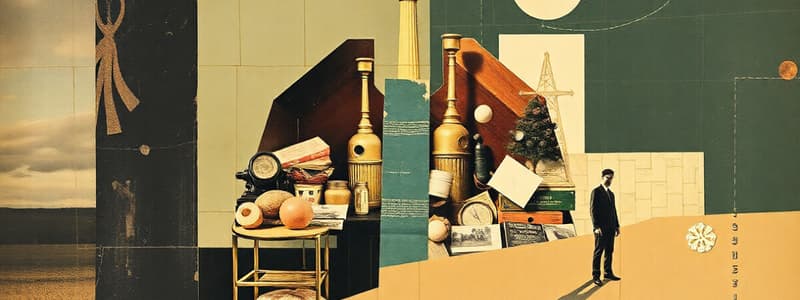Podcast
Questions and Answers
What is respiration?
What is respiration?
Respiration is the process of obtaining needed energy from the chemical reaction of glucose and oxygen.
Where does aerobic cellular respiration take place?
Where does aerobic cellular respiration take place?
Mitochondria
What are the products of aerobic cellular respiration?
What are the products of aerobic cellular respiration?
- Glucose, oxygen, and water
- Carbon dioxide, oxygen, and ATP
- Glucose, water, and ATP
- Carbon dioxide, water, and ATP (correct)
What is the primary function of gas exchange?
What is the primary function of gas exchange?
How does gas exchange occur in single-celled organisms and simple multicellular organisms?
How does gas exchange occur in single-celled organisms and simple multicellular organisms?
What is the role of specialized gas exchange tissue in complex multicellular organisms?
What is the role of specialized gas exchange tissue in complex multicellular organisms?
What does RBC stand for?
What does RBC stand for?
How is carbon dioxide transported throughout the body?
How is carbon dioxide transported throughout the body?
What are the three bony plates in the nasal cavity called?
What are the three bony plates in the nasal cavity called?
What structure is the common passageway for both food and air?
What structure is the common passageway for both food and air?
What is the function of the epiglottis?
What is the function of the epiglottis?
What part of the respiratory system contains the vocal cords?
What part of the respiratory system contains the vocal cords?
What is the trachea's primary function?
What is the trachea's primary function?
The cartilaginous rings of the trachea are complete rings.
The cartilaginous rings of the trachea are complete rings.
What is the function of the cilia in the trachea?
What is the function of the cilia in the trachea?
What is the connection between the trachea and the lungs called?
What is the connection between the trachea and the lungs called?
Bronchi contain cartilage rings, while bronchioles do not.
Bronchi contain cartilage rings, while bronchioles do not.
What is the main function of bronchioles?
What is the main function of bronchioles?
What are the microscopic air sacs in the lungs called?
What are the microscopic air sacs in the lungs called?
What type of tissue makes up the alveoli?
What type of tissue makes up the alveoli?
What is the function of the diaphragm?
What is the function of the diaphragm?
What are the two membranes that surround the lungs called?
What are the two membranes that surround the lungs called?
What is the function of the fluid in the pleural cavity?
What is the function of the fluid in the pleural cavity?
Air entering the pleural cavity can cause the lungs to collapse.
Air entering the pleural cavity can cause the lungs to collapse.
Flashcards
Aerobic Cellular Respiration
Aerobic Cellular Respiration
The process of obtaining energy from the chemical reaction of glucose and oxygen.
ATP (Adenosine Triphosphate)
ATP (Adenosine Triphosphate)
A molecule that stores and releases energy for cellular processes.
Gas Exchange
Gas Exchange
The exchange of carbon dioxide and oxygen molecules between the external environment (air) and the internal environment (blood).
Ventilation
Ventilation
Signup and view all the flashcards
Conchae
Conchae
Signup and view all the flashcards
Pharynx
Pharynx
Signup and view all the flashcards
Epiglottis
Epiglottis
Signup and view all the flashcards
Larynx
Larynx
Signup and view all the flashcards
Trachea
Trachea
Signup and view all the flashcards
Tracheal Rings
Tracheal Rings
Signup and view all the flashcards
Cilia
Cilia
Signup and view all the flashcards
Bronchus
Bronchus
Signup and view all the flashcards
Bronchioles
Bronchioles
Signup and view all the flashcards
Alveoli
Alveoli
Signup and view all the flashcards
Alveolar Wall
Alveolar Wall
Signup and view all the flashcards
Lungs
Lungs
Signup and view all the flashcards
Diaphragm
Diaphragm
Signup and view all the flashcards
Pleural Membranes
Pleural Membranes
Signup and view all the flashcards
Ribs
Ribs
Signup and view all the flashcards
External Intercostal Muscles
External Intercostal Muscles
Signup and view all the flashcards
Study Notes
Respiration: An Introduction
- Respiration is the process of inhaling and exhaling air.
- The main reason for respiration is to bring oxygen into contact with specialized tissue in the body. This maximizes oxygen transfer, crucial for cellular energy production.
- Aerobic cellular respiration: This process obtains energy from glucose and oxygen. It occurs in the mitochondria. The reaction is as follows: C6H12O6 + 6 O2 + 36ADP + 36Pi → 6CO2 + 6 H2O + 36ATP.
- Glucose is the source of energy from food.
- Most energy is lost as heat during respiration; only approximately 36% is used to create ATP.
- ATP (adenosine triphosphate) is produced using energy from the breakdown of glucose in the presence of oxygen.
- The energy from this reaction is used for phosphorylation of ADP to create ATP.
- The process is used to provide energy for various cellular functions, such as growth, reproduction, and movement.
Gas Exchange
- Gas exchange involves the exchange of carbon dioxide and oxygen between the external environment (air) and the internal environment (blood in capillaries).
- In single-celled organisms and simple multicellular animals, oxygen diffuses from the external environment into the cell(s) and carbon dioxide diffuses out.
- Complex multicellular organisms have specialized gas exchange tissue to maximize the efficient diffusion of oxygen and carbon dioxide.
- The path of oxygen: Oxygen enters the lungs, is picked up by red blood cells (RBCs), and carried throughout the body. It then dissolves into the interstitial fluid and diffuses into the cells where it is used for ATP production.
- Carbon dioxide follows a reverse path.
Ventilation
-
Ventilation is the movement of air in and out of the lungs.
-
The process involves inspiration (inhaling) and expiration (exhaling).
-
The lungs of a smoker appear darker and less voluminous, compared to healthy lungs, due to the effects of smoke.
The Human Gas Exchange Structures
- Nasal Cavity: Contains three bony plates (conchae) lined with a mucous membrane. It traps debris, moistens, and warms incoming air.
- Pharynx (Throat): A common passageway for both air (moving towards the trachea) and food (moving towards the esophagus).
- Epiglottis: A flap of tissue that prevents food and liquid from entering the trachea during swallowing.
- Larynx: Contains vocal chords (tendon-like tissue) used for producing sound when air passes through.
- Trachea: Brings air from the larynx to the lungs. It comprises C-shaped rings of cartilage to prevent collapse during breathing.
- Bronchi (singular = bronchus): Branches of the trachea supplying air to the lungs. They are supported by cartilage rings and lined with cilia and mucus.
- Bronchioles: Microscopic tubes that further branch from the bronchi, delivering air to alveoli (no cartilage).
- Alveoli (singular = alveolus): Tiny air sacs in the lungs where gas exchange occurs. They are supplied with capillaries and made up of thin epithelium which allows O2 to diffuse from the air into the blood and CO2 to diffuse from the blood into the air. The alveoli are approximately 70-90 m² in surface area.
- Lungs: Soft, elastic organs responsible for gas exchange, comprising three lobes in the right lung and two in the left.
- Diaphragm: A sheet of muscle that stretches across the bottom of the thoracic cavity. Its contraction and relaxation change the volume of the cavity, leading to inhalation/exhalation.
- Ribs: Support and protect the thoracic cavity. In breathing, the external intercostal muscles between the ribs pull them up and out to increase thoracic cavity volume.
Pleural Membranes
- Two pleural membranes surround the lungs.
- The inner membrane surrounds the lungs, and the outer membrane lines the thoracic cavity.
- A fluid-filled space known as the pleural cavity exists between the membranes to reduce friction.
- This reduces friction when the lungs move as the body breathes.
Studying That Suits You
Use AI to generate personalized quizzes and flashcards to suit your learning preferences.




